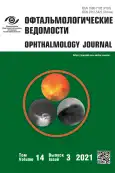Preferred treatment regimen of aflibercept after treatment interruption in patients with neovascular age-related macular degeneration
- 作者: Kharakozov A.S.1, Kulikov A.N.2, Maltsev D.S.2
-
隶属关系:
- S.M. Kirov Military medical academy
- S.M. Kirov Military Medical Academy
- 期: 卷 14, 编号 3 (2021)
- 页面: 17-24
- 栏目: Original study articles
- URL: https://journals.rcsi.science/ov/article/view/79934
- DOI: https://doi.org/10.17816/OV79934
- ID: 79934
如何引用文章
详细
BACKGROUND: The efficacy of antiangiogenic therapy in neovascular age-related macular degeneration depends on adherence to the intravitreal injection regimen and regular follow-up. In 2020, the COVID-19 pandemic and associated epidemiological restrictions in ophthalmological care delivery led to a massive lack of appropriate control and management of this condition.
AIM: To determine the preferred regimen of intravitreal anti-VEGF therapy in patients with neovascular age-related macular degeneration who experienced treatment interruption due to the COVID-19 pandemic.
MATERIAL AND METHODS: Thirty eyes of 26 patients (20 males and 6 females, mean age 73.7 ± 10.4 years) with neovascular age-related macular degeneration were included; all of them experienced treatment interruption due to the COVID-19 pandemic during the second year of aflibercept therapy. Re-starting therapy, all patients were divided in two groups and received treatment as per the fixed dosing (bimonthly), or as pro re nata (PRN) regimen. All patients underwent standard ophthalmological examination and optical coherence tomography before and after treatment interruption as well as six months after treatment re-start.
RESULTS: At six months after treatment re-start, best corrected visual acuity and central retinal thickness did not show statistically significant difference similar between the fixed dosing group and that of PRN dosing regimen (p = 0.34 and p = 0.85, respectively). However, patients of the fixed dosing group received for one more injection than those of the PRN group (median value – 2.0 injections, 95% confidence interval – 2.0-2.4; p = 0.0001). Preservation of the disease activity according to optical coherence tomography data, in the fixed regimen group was found in 10 eyes (71.4 %) versus 9 eyes (56.2 %) in the PRN group (p = 0.63).
CONCLUSIONS: For neovascular age-related macular degeneration patients at the second year of treatment, an adequate therapeutic strategy for re-starting anti-VEGF therapy after treatment interruption appears to be the PRN regimen. PRN regimen allows reducing one injection in comparison to fixed dosing regimen with comparable functional outcomes during first 6 month.
作者简介
Aleksandr Kharakozov
S.M. Kirov Military medical academy
编辑信件的主要联系方式.
Email: kharakozoff@mail.ru
ORCID iD: 0000-0003-4598-0826
SPIN 代码: 1208-5237
assistant head of department, ophthalmologist 俄罗斯联邦, 6G, Akademika Lebedeva street, Saint-Petersburg, 194044
Alexey Kulikov
S.M. Kirov Military Medical Academy
Email: alexey.kulikov@mail.ru
ORCID iD: 0000-0002-5274-6993
SPIN 代码: 6440-7706
Scopus 作者 ID: 57001225300
Researcher ID: M-2094-2016
MD, PhD, DMedSc, Professor, Head of the Department, Ophthalmology Department
俄罗斯联邦, 6G, Akademika Lebedeva street, Saint-Petersburg, 194044Dmitrii Maltsev
S.M. Kirov Military Medical Academy
Email: glaz.med@yandex.ru
ORCID iD: 0000-0001-6598-3982
MD, PhD, DMedSc, head of the department of laser surgery of the ophthalmology department
俄罗斯联邦, 21/1, Botkinskaya str., Saint Petersburg, 194044参考
- Singer MA, Awh CC, Sadda S, et al. HORIZON: An open-label extension trial of ranibizumab for choroidal neovascularization secondary to age-related macular degeneration. Ophthalmology. 2012;119(6):1175–1183. doi: 10.1016/j.ophtha.2011.12.016
- Thomas DS, Warwick A, Olvera-Barrios A, et al. Estimating excess visual loss in people with neovascular age-related macular degeneration during the COVID-19 pandemic. [Internet] medRxiv. June 05, 2020. [cited 2021 February 20]. Available from: https://doi.org/10.1101/2020.06.02.20120642.
- Onufriichuk ON, Gazizova IR, Malyugin BE, Kuroyedov AV. Coronavirus Infection (COVID-19): Ophthalmic Problems. Literature Review. Fyodorov Journal of Ophthalmic Surgery. 2020;(3):70–79. (In Russ.) doi: 10.25276/0235-4160-2020-3-70-79
- Real JP, Luna JD, Palma SD. The reactivation time in the treatment of AMD: a forgotten key parameter? Graefe’s Archive for Clinical and Experimental Ophthalmology. 2018;256(6):1079–1087. doi: 10.1007/s00417-018-3974-0
- Borrelli E, Grosso D, Vella G, et al. Short-term outcomes of patients with neovascular exudative AMD: the effect of COVID-19 pandemic. Graefes Arch Clin Exp Ophthalmol. 2020;258(12):2621–2628. doi: 10.1007/s00417-020-04955-7
- Kharakozov AS, Kulikov AN, Maltsev DS. Effects of treatment interruption on anatomical and functional status of eyes with neovascular age-related macular degeneration receiving anti-VEGF therapy. Ophthalmology Journal. 2021;14(1):35–42. (In Russ.) doi: 10.17816/OV59966
- Jaffe GJ, Kaiser PK, Thompson D, et al. Differential response to anti-VEGF regimens in age-related macular degeneration patients with early persistent retinal fluid. Ophthalmology. 2016;123(9): 1856–1864. doi: 10.1016/j.ophtha.2016.05.016
- Astakhov YS, Nechiporenko PA. Dosing regimens of angiogenesis inhibitors in the treatment of neovascular age-related macular degeneration patients. Ophthalmology Journal. 2019;12(2):47–56. (In Russ.) doi: 10.17816/OV12247-56
- Chin-Yee D, Eck T, Fowler S, et al. A systematic review of as needed versus treat and extend ranibizumab or bevacizumab treatment regimens for neovascular age-related macular degeneration. Br J Ophthalmol. 2016;100(7):914–917. doi: 10.1136/bjophthalmol-2015-306987
补充文件








